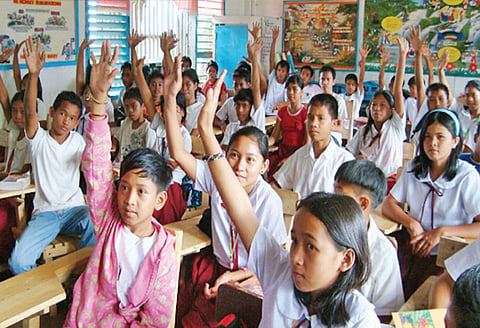Conditional grants kept poor children in school, World Bank says
Study shows programme also helped improve and maintain health standards

Manila: Conditional cash assistance to the poorest of the poor had proven to be effective in keeping children in school while helping to maintain their health, the World Bank said, citing results of a study.
World Bank country director for the Philippines, Motoo Konishi said studies show that programmes initiated by the organisation, such as the Conditional Cash Transfer (CCT), had delivered on its objectives of keeping children in school while at the same time improving or maintaining their health.
“Two rounds of rigorous impact evaluation show that they [poor families] use the money to buy food, school uniforms and school supplies for their children,” he said.
Started sometime in 2008, the CCT programme is intended to provide help to the “poorest” sectors of the society to help even out unbalanced development.
World Bank studies had revealed that a significant part of the society had been left out from the benefits of economic development thus leaving the poor in the same impoverished state they have been mired in despite the improvements to the country’s fortunes.
Results of their study showed that enrolment among poor elementary schoolchildren increased by 5 percentage points, while secondary education enrolment increased by 7 percentage points.
In the Philippines, education is free, however expenses attendant to going to school are not and in some cases, children from the poor had to forego free government schooling because they do not have money to pay for purchase of notebooks, pencils, etc.
The World Bank also said that the CCT had also resulted in the increased prenatal and postnatal care by 10 percentage points and increased the delivery of babies in health facilities by skilled health professionals by 20 percentage points.
“Children benefited by receiving higher intake of vitamin A and iron supplementation by around 12 percentage points and by increased weight monitoring visits to health facilities by 18 percentage points,” the World Bank said.
Earlier, there had been concerns that the CCT is being used by certain politicians, particularly those in the local level.
But according to Department of Social Welfare and Development (DSWD) Secretary Corazon Soliman, the government is currently updating the list of beneficiaries and purging those who do not require assistance from the roster.
“As we speak, DSWD field workers are completing the data collection to update the database,” said Soliman during a briefing Wednesday on “The State of Social Safety Nets 2015 and World Bank Lead Technical Expert on Social Safety Nets.”
During the meeting, Ruslan Yemtsov, who led the preparation of the report, said that as of August, the WB we have collected data from almost 11 million households in the Philippines.
“The target is 15.3 million, or 75 per cent of all households in the Philippines. This updated database of poor and vulnerable households across the country will be the basis to select the succeeding sets of CCT beneficiaries,” he said.
Almost 4.5 million Filipino households are enrolled in the CCT from only 360,000 households in 2008.
“The CCT grants, on average, only account for about 11 per cent of the income of the poorest recipient households,” said Konishi.
Earlier, the some officials of the Catholic Church such as Archbishop Oscar Cruz had derided the WB-initiated programme saying the scheme is “a novel way of making the poor downright mendicants while at the same time providing a creative means for the administration to generously giving away public funds to its chosen private recipients.”
Sign up for the Daily Briefing
Get the latest news and updates straight to your inbox



